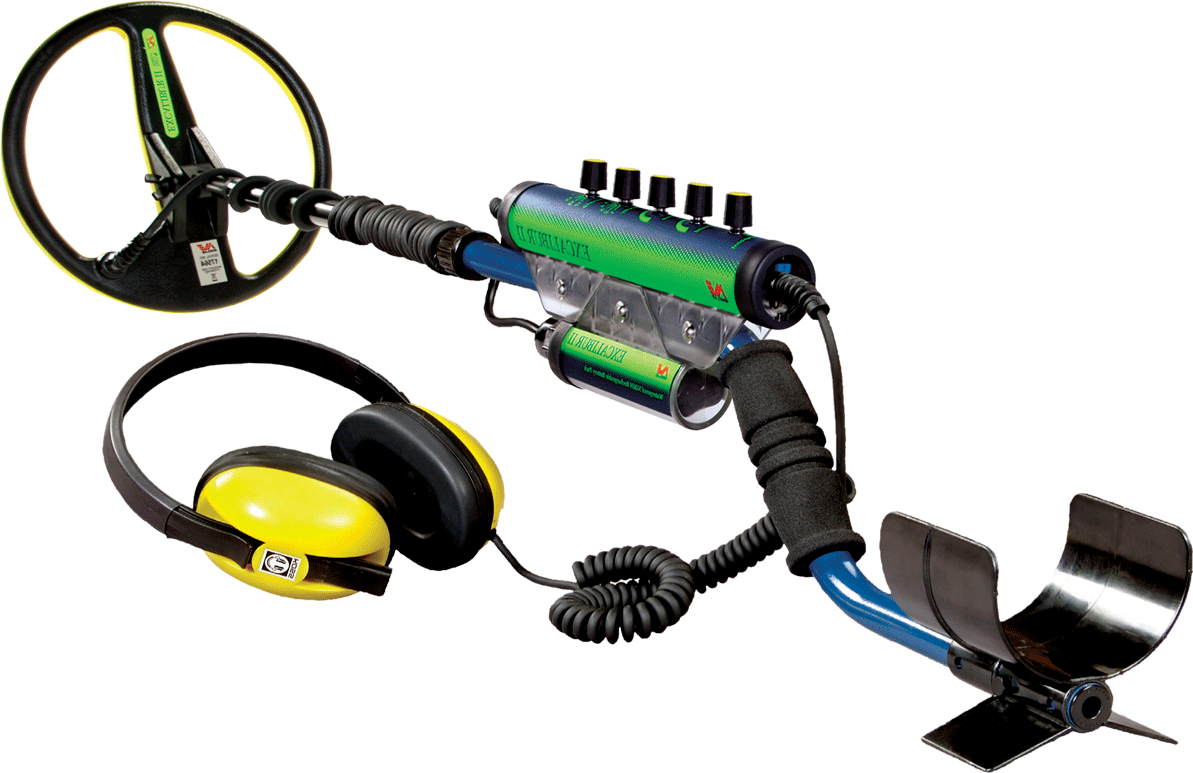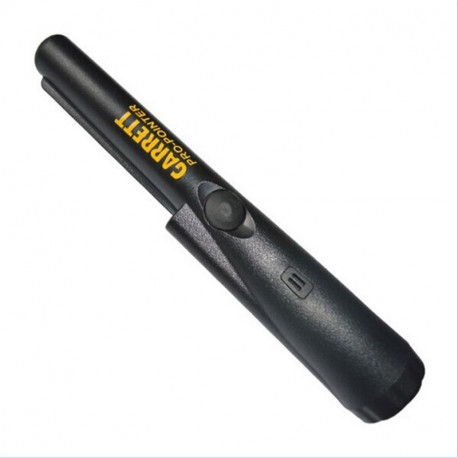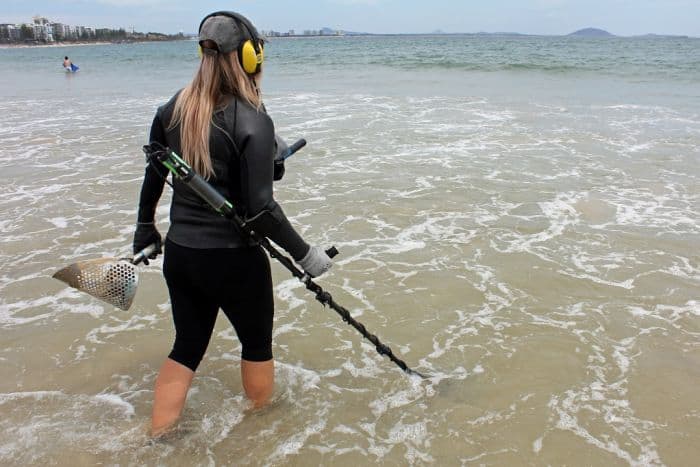If you were looking for buried treasure, would you search on an Island that Pirates were shipped wrecked on? The best place to use a Metal Detector just may be the shallows near tidal water. With the proper tools and techniques can you find treasure in shallow water. What are some tips for using a metal detector in shallow water on the beach?
- Use a waterproof detector & accessories
- Search during low tide for more exposed area
- Start along the shoreline & work deeper gradually
- Watch for hazards like rocks or currents
- Use a waterproof pinpointer for precision
- Be gentle to avoid stirring up sediment
- Rinse equipment with fresh water after use
- Follow local regulations & respect the environment
With the right equipment and the right instructions, you can make some finds that you probably walked over a few times not knowing that the ground right under your feet was where you should have been looking all along.
Metal Detecting Beach Tips
If you’re worried about losing something in your pockets at the beach on any given day well you have a good reason. People have been losing items like rings, coins, and keys for a hundred years. The violent surf kicks up the sand and strong currents rip up the whole area sometimes where you can’t recognize the place a day after you spent the whole week there.
If you ever had the misfortune of losing a ring swimming in the surf and no matter how clear the ocean is that day, you soon realize it’s a hopeless situation diving underneath the water to try and recover it.
Think about it, a beach in New Jersey like Atlantic City. How many millions of people have visited the beach throughout a couple of hundred years and have laid on the beach and swam in the surf? How many of those men and women have lost a coin or a ring something of value?
Some people look at this beach and see the sun and fun, some people see fish that they could catch. Some people see gold treasure buried within feet of the surf the same surf that’s been pounding the same beach for two hundred years. It’s kind of a different way of looking at things. I look at life a little differently.
Pulse Induction Metal Detector vs VLF
There are two different types of Waterproof Metal Detectors Technologies today they are:
- Pulse Induction Metal Detector-Transmit a series of quick electronic pulses into the ground these signals are not affected by wet salt sand or minerals found in the ground. They are highly sensitive to precious metals. They are the best instruments to use on beaches, in saltwater, and in ocean diving. The Pulse circuit is very deep seeking it has limited discrimination capabilities so you will need to dig more trash items to get to the big prize.
- (VLF) Very Low-Frequency Metal Detectors-(VLF)-Typically operate in the 3-30 kHz frequencies and are very sensitive to coins and jewelry. The VLF detectors can discriminate against junk targets while still finding the good stuff you’re looking for. Most VLF detectors have a sensitivity control and by adjusting this knob you can minimize ground signals caused by minerals.
Pulse Induction Metal Detector for the Beach
There are a few companies that make great detectors. You may want a metal detector that will work on land and is waterproof. You can find one here at MyWaterEarth&Sky the Minelab Excalibur II 800 Garden Metal Detector is great-priced. It only weighs about 7-8 lbs. so you’re not killing yourself lugging around heavy equipment you don’t need.
 You need to make sure the detector alarms when it detects gold and has large enough target IDs that are easy to read and distinguish apart from each other. The machine should be able to distinguish or discriminate between different targets either set manually or automatically.
You need to make sure the detector alarms when it detects gold and has large enough target IDs that are easy to read and distinguish apart from each other. The machine should be able to distinguish or discriminate between different targets either set manually or automatically.
You would think they all do but they all don’t. Also, saltwater tends to ruin electronic or electrical equipment so you need a metal detector that will not only be water-proof but will be able to withstand the corrosive nature of saltwater.
A good unit will always have an easy instructional learning curve to operate. I want to find the buried treasure I’m not interested in becoming an engineer or an electronics expert. You don’t want the sand to be an obstacle either because even though you looking underwater you still are looking under sand too. Black sand typically hurts metal detector readouts. Battery life should be comparable and easy to maintain.
The detector needs a comfortable harness. Headphones are not all waterproof and the chances of you dumping a set in the surf- trust me on this one guy… you’ll drop them. The last thing is depth and that would depend on where you are going to use it. Normally you have to pull your headphones off before you start digging So wireless headphones are a great idea.
Metal Detector Digging Tools for Use on the Beach

Aluminum Sand Sifter
The right Shovel is a must and next to the detector is your best tool. Shovels should have root cutters on the side for ground digs and good footpegs for underwater digs and are very strong and reliable. The shovel should be a least 36 inches long and made of tempered steel.
Recovery Tools should have a padded handle and a double-edge surrogated blade on both sides. It should be able to attach to your belt for easy access. Made of durable steel.
A Plastic or Aluminum Sand Sifter Scoop is a necessary tool with no interference and the long-handle sand scoop to keep your back from the work should be lightweight and telescopic and an easy cleanup tool.
A Pointer is like the one in the left picture and adds a complement or tool to your detector to help you get into smaller places to pinpoint your area exactly and to help locate your target faster with less work. A Pointer that is rugged waterproof and floats. It should have a flashlight and alarm or vibrate or both. Some have scraper or protective point covers.

Hunting for treasures on the beach or in the surf comes with a few obstacles. The most important consideration is the minerals that you find there. Saltwater and the so-called Hot Rocks that you find there are the necessary evils that you must deal with. Saltwater will amplify the normal minerals that you find there causing many land-based detectors to give off false signals. The best unit for the beach is the Pulse Induction Technology (PI) detector, unfortunately, they are a little expensive.
Underwater metal detectors are determined by salt or fresh water and according to how deep you will be diving. This depth rating is different from the depth rating of how deep the alarm signal reads after picking up a target. It will be the driving range of the instrument. In most cases, Pulse Induction(PI) is the better choice for a metal detector. Most under detectors come with waterproof headphones.
They are made to turn on and go and cancel out black sand, and minerals, and eliminate junk targets to get to what you’re looking for. The VLF models have nicer displays and can differentiate from audio target identification capabilities but are better than the PI models but are more sensitive and require more balancing and tweaking.
If you are willing to get a little wet then shallow water treasure hunting with a detector is what you’re looking for. Treasure rolls in and out with the tide all in less than 6 feet of water. Most hunters are on the beach in the sand while the divers are out in deeper water.
You can be in the waist-high water zone finding coins jewelry and watches that are moved around by the tide. You can snorkel or scuba on the bottom or cover the area with the tide out on a knee-deep ocean floor. Try it in a pond, river, or lake too.
Where Can You Use a Metal Detector Legally
I live on the East Coast shoreline where history covers the entire area and hundreds of miles inland too along the Delaware River. It’s where the Revolutionary and Civil Wars were fought and hosted in the most historical part of America.
There is a law on shallow water Metal Detecting in the Florida Gulf Region called Florida’s State Laws of Antiquities that regulates the taking of old valuables from certain state lands and even the coastal waters. It’s up to you to find out if the County and State you are detecting in have laws against Metal Detecting.
You’ll be using the tide to your advantage. Shallow water hunters should always work in the tide area. Arrive at the beach a few hours before low tide working the area as the tide recedes. This is prime time. Do this right up until the tide comes in again.
Experts say the most productive area is the deep water areas where people swim at high tide. They also say that wind and storm line vicinity is where items are sometimes deposited all in the same area. So if you do get a signal, mark that area. It’s most likely there will be more than one item of the same weight that will wash up together by the tide in the surf or in a high tide line around a river or creek.
- Metal detecting laws vary depending on location, so it’s essential to research and understand local regulations before detecting.
- Public beaches and parks are often popular locations for metal detecting, but specific rules may apply, such as obtaining permits or avoiding protected areas.
- Some private properties allow metal detecting with the owner’s permission, while others may have restrictions or prohibit it altogether.
- Cultural heritage sites, including archaeological sites and protected areas, are typically off-limits to metal detecting to preserve historical artifacts and prevent damage to the environment.
- Always respect the rules and regulations of the area you’re detecting in to ensure you’re detecting legally and responsibly.
Metal Detecting in Shallow River Water
The Community Library may be the best place to research an area that may hold historical value and was a popular place at one time. Also, places like Colleges and Historical Societies are reliable. Because the ocean is so vast and a constant source of movement connected to a shoreline, most people would agree that it is the best place to recover valuables and agree that buried treasure exists there, somewhere and the possibilities are endless.
Tidal Rivers and Beaches that were once popular places to go by many people long ago could hold large amounts of treasure, those people may have left behind loads of treasure that are now buried in that space covered by mud and sand in the shallow water under your feet.
Conclusion:
Metal detecting in shallow water offers a unique and rewarding opportunity to discover lost treasures beneath the waves. By equipping yourself with the right gear, understanding local regulations, and prioritizing safety, you can explore beaches, lakeshores, and other aquatic environments responsibly. With careful planning, methodical searching, and the use of specialized tools like waterproof metal detectors and pinpointers, you can uncover a variety of items submerged in shallow waters. Remember to respect the environment, follow any applicable rules and guidelines, and enjoy the adventure of uncovering history beneath the surface.
References:
High Plains Prospector-Metal Detecting in Shallow Water
FAQ’s
Is metal detecting in shallow water legal?
Metal detecting laws vary by location, so it’s crucial to research and abide by local regulations. In many areas, metal detecting in shallow water is permitted, but certain restrictions or permits may apply.
What equipment do I need for metal detecting in shallow water?
You’ll need a waterproof metal detector, waterproof headphones, a waterproof pinpointer, and possibly a sand scoop or digging tool designed for use in water. Ensure all equipment is rated for underwater use to prevent damage.
Where are the best places to metal detect in shallow water?
Popular locations for shallow water metal detecting include beaches, swimming areas, docks, boat ramps, and areas where people gather near the water’s edge. Search along the shoreline and in shallow areas where items are likely to be lost or dropped.
How deep can I metal detect in shallow water?
The depth you can detect will depend on the capabilities of your metal detector and the conditions of the water. Generally, shallow water metal detecting is limited to depths where you can comfortably wade or submerge your detector.
What types of items can I expect to find while metal detecting in shallow water?
Common finds in shallow water include coins, jewelry, keys, watches, and other small items lost by beachgoers or boaters. Additionally, historical artifacts and relics may be uncovered in areas with a rich maritime history.




